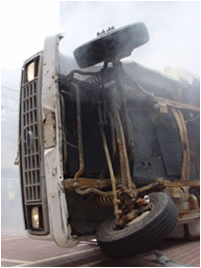
Whether a pesticide spill is small or large, a fast and correct response can prevent disaster – techletter.com
In case of a pesticide spill, follow the “Three C’s” – control, contain, and clean up. Control the spill immediately to prevent further spillage. Contain the spill by diking the spill with absorbent material or sorbent pads to keep it out of the water and prevent environmental contamination. Clean up the spill. Use absorbent material to soak up the spill, then shovel contaminated material into a plastic storage container for disposal. Refer to the PES Spill section for more information.
For an accident that results in a spill, do not leave the scene, but make sure you are safely away from danger. A suggested sequence of calls to make is:
- Notify your employer.
- Call 911, the State Patrol, or the emergency response telephone number if listed on shipping papers.
Give as much information as you can safely.
- Your name, and telephone number.
- Location and nature of the problem.
- Name and identification number of material(s) involved.
- Vehicle description and license number.
- Type and size of the container(s).
- Quantity of material transported/released.
- Local conditions, including weather conditions and proximity to hospitals, schools, and bodies of water. You may be required to call the state environmental agency if surface water may be contaminated by the spill.
In the Event of a Fire
If there is a fire,
- Call 911, give the location of the fire and explain that pesticides are involved.
- Call a nearby hospital so they can be prepared to treat the injured for pesticide exposure. Send a list of the pesticides (copy of the shipping document) involved in the accident to the hospital with the injured.
- Where possible, start first aid but avoid contact with the pesticides. Wear gloves to move victims to a pesticide-free area. Immediately remove clothing contaminated with pesticides and warn others of the danger.
- Do not try to extinguish the fire without adequate protective clothing and respiratory protection.
- Keep all people upwind of the accident and if there is a fire, evacuate nearby buildings.
- Avoid breathing smoke, fumes, vapors, or dusts.
- At a minimum, wear rubber boots and gloves.
- Avoid using large amounts of water to extinguish a fire to keep toxic runoff to a minimum.
- For liquids, control runoff with dikes using equipment from your spill kit. Block routes to sewer lines and storm runoff inlets so the runoff can be recovered and environmental contamination kept to a minimum.
- Cover powdered pesticides with a tarp to prevent the movement of toxic dust by winds or passing vehicles.
Procedures after an Accident
To protect yourself follow these personal precautions and encourage others to do the same.
- As soon as possible, wash and shower using large amounts of soap and water to remove all toxic chemicals. Pay special attention to the scalp, fingernails, all skins folds, ears, nose, and eyes.
- Wash all personal clothing and protective clothing. Clean respirators according to equipment directions. Discard contaminated leather and canvas shoes, boots, and gloves. If worn again, they may expose you to pesticides that could cause skin problems, other toxicity symptoms, and even death, depending upon the chemicals involved
- Watch for early symptoms of pesticide poisoning such as headache, dizziness, nausea, sweating, or blurred vision. These symptoms may show up immediately or after several hours.
Compiled by Jan Hygnstrom, Erin Bauer, and Clyde Ogg, University of Nebraska – Lincoln
